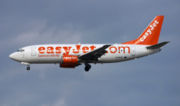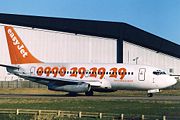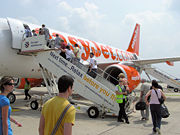EasyJet
2008/9 Schools Wikipedia Selection. Related subjects: Companies
| easyJet | ||
|---|---|---|
 |
||
| IATA U2 |
ICAO EZY |
Callsign EASY |
| Founded | 1995 | |
| Hubs | London Luton Airport London Gatwick Airport Berlin-Schönefeld International Airport Geneva Cointrin International Airport Edinburgh Airport Glasgow International Airport London Stansted Airport Liverpool John Lennon Airport Newcastle Airport Belfast International Airport Dortmund Airport East Midlands Airport Basel Airport Orly Airport Milan Malpensa Airport Bristol International Airport Madrid Barajas International Airport Paris Charles de Gaulle Airport Lyon Airport Manchester Airport (From April 2008) |
|
| Fleet size | 137 (120 on order) |
|
| Destinations | 80 | |
| Parent company | easyJet PLC | |
| Headquarters | ||
| Key people | Andrew Harrison ( CEO) Cor Vrieswijk ( COO) Jeff Carr ( CFO) |
|
| Website: http://www.easyJet.com | ||
EasyJet (LSE: EZJ), styled as easyJet, is a low cost airline officially known as EasyJet Airline Company Limited, based at London Luton Airport. It is one of the largest low-fare airlines in Europe, operating domestic and international scheduled services on 307 routes between 80 key European cities.
The company holds a United Kingdom Civil Aviation Authority Type A Operating Licence permitting it to carry passengers, cargo and mail on aircraft with 20 or more seats.
History
The airline was established on 18 October 1995 and started operations on 10 November 1995. It was launched by Stelios Haji-Ioannou with two Boeing 737-200 aircraft wet leased from Independent Aviation Group Limited ("IAG"). IAG, in turn, sub-contracted the operation of the aircraft to GB Airways, and then to Air Foyle from May 1996 onwards. EasyJet initially operated two routes: London Luton to Glasgow and Edinburgh. Its early marketing strategy was based on 'making flying as affordable as a pair of jeans' and urged travellers to 'cut out the travel agent'. In March 1998 it purchased a 40% stake in TEA Switzerland, renamed EasyJet Switzerland. EasyJet was floated on the London stock exchange in October 2000. Operations were boosted in 2002 with the acquisition of rival airline, London Stansted based Go Fly. In December 2003 EasyJet announced it would open a new hub in Berlin, at Schönefeld Airport, from which it started flying on 11 routes from May 2004.
In October 2004 the FL GROUP, the owner of airlines Icelandair and Sterling, purchased an 8.4% stake in EasyJet. Over the course of 2005, FL increased its share in the company periodically to 16.9%, fuelling speculation that it would mount a takeover bid for the UK carrier. However, in April 2006 the threat of takeover receded as FL sold its stake for €325m, securing a profit of €140m on its investment. In November 2005 chief executive Ray Webster stood down after 10 years at the helm. He was replaced by ex RAC/Lexx Group chief, Andy Harrison.
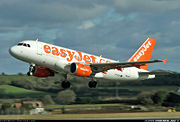
EasyJet was prevented from launching its Milan Malpensa- Olbia route in April 2006 by the Italian aviation authorities. The route had been assigned to Meridiana as a public service obligation route. The Italian authorities had granted exclusivity in return for fixed low fares for Sardinian residents on routes from Milan and Rome to the Sardinian airports of Alghero, Cagliari and Olbia. This was however overturned and EasyJet commenced flights from Milan Malpensa airport to Olbia (21st October, 2007) as well as Sardinia's capital, Cagliari (29th October, 2007).
EasyJet announced preliminary results for the year to September 2006. In the year it had grown its fleet to 122 aircraft and expanded its network to 262 routes and 74 airports in 21 countries (58 new routes and 11 new destinations had been introduced in the year). Passenger numbers rose by 11.5% to 33 million and it was able to post a record profit of £129 million before tax, a rise of 56% over 2005
It was announced on 25 October 2007 that EasyJet is to buy GB Airways. The deal is worth £103.5M and will be used to expand EasyJet operations at London Gatwick Airport and to start a new base at Manchester Airport. GB Airways will continue to honour its British Airways franchise agreement and continue to operate as GB Airways until 29 March 2008, after which it will be merged into EasyJet. Slots used by GB Airways at London Heathrow Airport are not included in the sale.
Relationship between EasyJet and the "easy" brand
EasyJet does not own its brand, unlike most other airlines. Sir Stelios Haji-Ioannou, the founder and largest individual shareholder of EasyJet Airline Co. Ltd. has sole ownership of the "easy" brand and licenses it to his airline (as well as to all other easyGroup businesses). For most easy businesses, the business pays a specified fee to Stelios for the use of the name. However, given the strength of the EasyJet brand and the high amount of free advertising and publicity it lends to the other 'easy' businesses, it was agreed at the time of flotation that EasyJet could use the name royalty free.
In this case, this kind of arrangement would be of importance should EasyJet ever become the subject of a hostile takeover bid. Any bidder[s] will not automatically acquire ownership of the "easy" brand if their bid for the airline is successful. Without securing access to that brand, the airline will be worth a lot less to any new owner[s]. This arrangement is similar to the terms governing the use of the Jet Airways brand by that airline.
EasyJet is now a public limited company listed on the London Stock Exchange and members of the Haji-Ioannou family own approximately 43%. It has 3,875 employees (at March 2007) It is a constituent of the FTSE 250 Index.
Strategy
Borrowing its business model from American air carrier Southwest, EasyJet and its Republic of Ireland-based rival Ryanair are two of the largest low cost airlines in Europe, and the rivalry between them is intense (especially on Ryanair's side from its high profile chief executive Michael O'Leary). The two companies have slightly different strategies. EasyJet flies mainly to leading airports while Ryanair uses far more secondary airports to reduce costs. EasyJet places more focus on attracting business travellers as well as leisure travellers, although all its aircraft have single-class cabins.
Bases/hubs
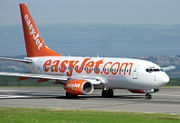
EasyJet's first base was London Luton (LTN) (and is still the location of its headquarters), although its largest base is at London Gatwick (LGW). Other bases:
- Belfast International Airport (BFS),
- Berlin-Schönefeld International Airport (SXF), (Largest base outside the UK)
- Bristol International Airport (BRS), (Largest UK base outside of London)
- Dortmund Airport (DTM),
- East Midlands Airport (EMA),
- Edinburgh Airport (EDI),
- EuroAirport Basel-Mulhouse-Freiburg (BSL),
- Geneva Cointrin International Airport (GVA),
- Glasgow International Airport (GLA),
- Liverpool John Lennon Airport (LPL),
- London Stansted (STN),
- Madrid Barajas International Airport (MAD)
- Malpensa International Airport, Milan (MXP),
- Newcastle international Airport (NCL),
- Orly Airport, Paris (ORY)
- Paris Charles de Gaulle Airport (CDG)
- Lyon Airport (LYS)
- Manchester Airport (MAN) [begins 30 March]
Destinations
Fleet
The EasyJet fleet consists of the following aircraft (at September 2007):
| Aircraft | Total | Passengers |
|---|---|---|
| Airbus A319-100 | 107* (120 orders) |
156 |
| Boeing 737-700 | 30 | 149 |
* Includes 12 aircraft placed with EasyJet Switzerland.
In August 2006, the EasyJet fleet average age was 2.2 years.
EasyJet initially operated exclusively Boeing 737 aircraft. In September 2003 it broke with its previous philosophy of operating just one aircraft type (a strategy popularised by Southwest Airlines) by ordering 120 Airbus A319s (and 120 options) with CFM56-5B engines. These were first introduced to EasyJet's Geneva base, UK bases followed from 2004. EasyJet still operates the Boeing 737-700 at London Luton, Belfast and Newcastle.
| Date | Orders | Options | Notes |
|---|---|---|---|
| September 2003 | 120 | 120 | |
| December 2005 | 140 | 100 | 20 options converted |
| November 2006 | 192 | 123 | 52 options converted 75 new options |
| June 2007 | 227 | 88 | 35 options converted |
Boeing 737-300 retirement was completed in 2006.
In December 2006 the airline started to return the Boeing 737-700s to their owners (all EasyJet Boeing aircraft are leased however the Airbus fleet is a mix of owned and leased aircraft).
The fleet financing target of EasyJet is to have a 70% owned fleet with the remaining 30% being leased. (Source: easyJet 2007 Preliminary Results Presentation.)
It is planned that all Boeing aircraft will be phased out of the fleet by 2011.
London Luton, the second largest base for EasyJet will slowly start converting to an Airbus only operation from Summer 2008.
Through the takeover of GB Airways, EasyJet plans to inherit nine Airbus A320s and six Airbus A321s (longer variants of the A319 aircraft currently operated).
Previously operated
- Boeing 737-200
- Boeing 737-300
Booking
Initially booking was by telephone only, with all planes painted with the booking telephone number. There is no incentive for travel agents to sell EasyJet bookings because there is no commission, a standard practice for the low cost carriers. In December 1997, Russell Sheffield of Tableau, one of EasyJet's Design and Adverting Agencies, suggested to Stelios that he should consider trialling a website for direct bookings. Stelios's reply was 'The Internet is for nerds, it will never make money for my business!'. However Tony Anderson, EasyJet's Marketing Director saw the potential and approved a website trial involving putting a different telephone reservations number on the website, to track success. Once Stelios saw the results he changed his mind, and EasyJet commissioned Tableau to partner with them develop an e-commerce website capable of offering real-time online booking from April 1998 — the first low cost carrier to do so in Europe. Internet bookings were priced cheaper than booking over the phone, to reflect the reduced call centre costs and the planes were repainted with the web address. Within a year over 50% of bookings were made using the web site, by April 2004 the figure had jumped to 98%. Now, flights can only be booked over the Internet except during the 2 weeks immediately before the flight when telephone booking is also available.
Passenger numbers
EasyJet has published the following passenger numbers:
- Year ended 30 September 2007: 37,230,079
- Year ended 30 September 2006: 32,953,287
- Year ended 30 September 2005: 29,557,640
- Year ended 30 September 2004: 24,343,649
- Year ended 30 September 2003: 20,332,973
- Year ended 30 September 2002: 11,400,000
- Year ended 30 September 2001: 7,100,000
- Year ended 30 September 2000: 5,600,000
- Year ended 30 September 1999: 3,100,001
These are "earned seat" numbers. Earned seats is a method of counting passenger numbers which includes all seats sold whether the passenger turns up or not, and also seats used for promotional purposes and staff business travel.
Controversy
EasyJet's success arguably paved the way for the boom in cheap air travel in the late 1990s and early 2000s (though they were not the first no frills carrier, nor the first large one in Europe).
This has led EasyJet being accused, amongst other no frills carriers, of contributing to global warming through the high carbon emissions of aircraft. Low-cost carriers (and their trade association, ELFAA) argue that they tend to operate newer, more fuel-efficient aircraft than many full-service network airlines, and also that their point-to-point services use less fuel than connecting flights through a hub. (Most of the hub-and-spoke systems run by traditional full-service network airlines, such as Air France-KLM, British Airways and Lufthansa as well as their US legacy carrier counterparts, generally rely on a range of mostly profitable long-haul flights being "fed" by a large number of often only marginally profitable or wholly loss-making short-haul connecting flights via their main hub airports. The reason the network carriers "feed" their long-haul services with short-haul connecting traffic is to shore up the profitability of the long-haul flights, most of which would not attract sufficient traffic on their own to be profitable.)
Against this, the no frills carriers' aggressive price-based marketing has driven a rapid growth in their passenger volumes, so the negative environmental effects of aviation are growing rapidly.
Apart from the initial pair of 737-200s leased from GB Airways - the airline has only ever operated new aircraft, either 737-300s, 737-700s or Airbus A319s. The newer aircraft are advertised to produce lower emissions and be more environmentally friendly.
EasyJet has also come under criticism in Germany for not observing EU-law 261/2004. In the case of cancellation, passengers had the right to be reimbursed within one week. In 2006, EasyJet had experienced difficulties in refunding tickets in a timely fashion. Passengers occasionally had to wait longer for reimbursement of their expenses.
Other facts
- On 14 December 2004, EasyJet and Hotelopia, a subsidiary of First Choice Holidays, launched a co-branded EasyJetHotels accommodation booking service.
- Due to higher density passenger seating and the enforced extra safety requirement, EasyJet's Airbus A319 aircraft have two pairs of overwing exits instead of standard one-pair exits found on all other Airbus A319 .
- The UK television station ITV1 has run a series called Airline (UK TV series) filmed at London Luton Airport and Liverpool John Lennon Airport. This was also aired in the United States as A&E Network show Airline UK.
- In June 2006, the EasyJet website was awarded the Best Airline Website award TravelMole Web Awards. It beat rivals including British Airways, KLM and Vueling to win the award. Judges commented that although actual contact with the airline can be hard, the website was 'user-friendly and pleasing to the eye'.
- EasyJet is a major supporter of the plans to replace the Air Passenger Duty (APD) tax in the UK with a new tax that varies depending on distance travelled and aircraft type.
